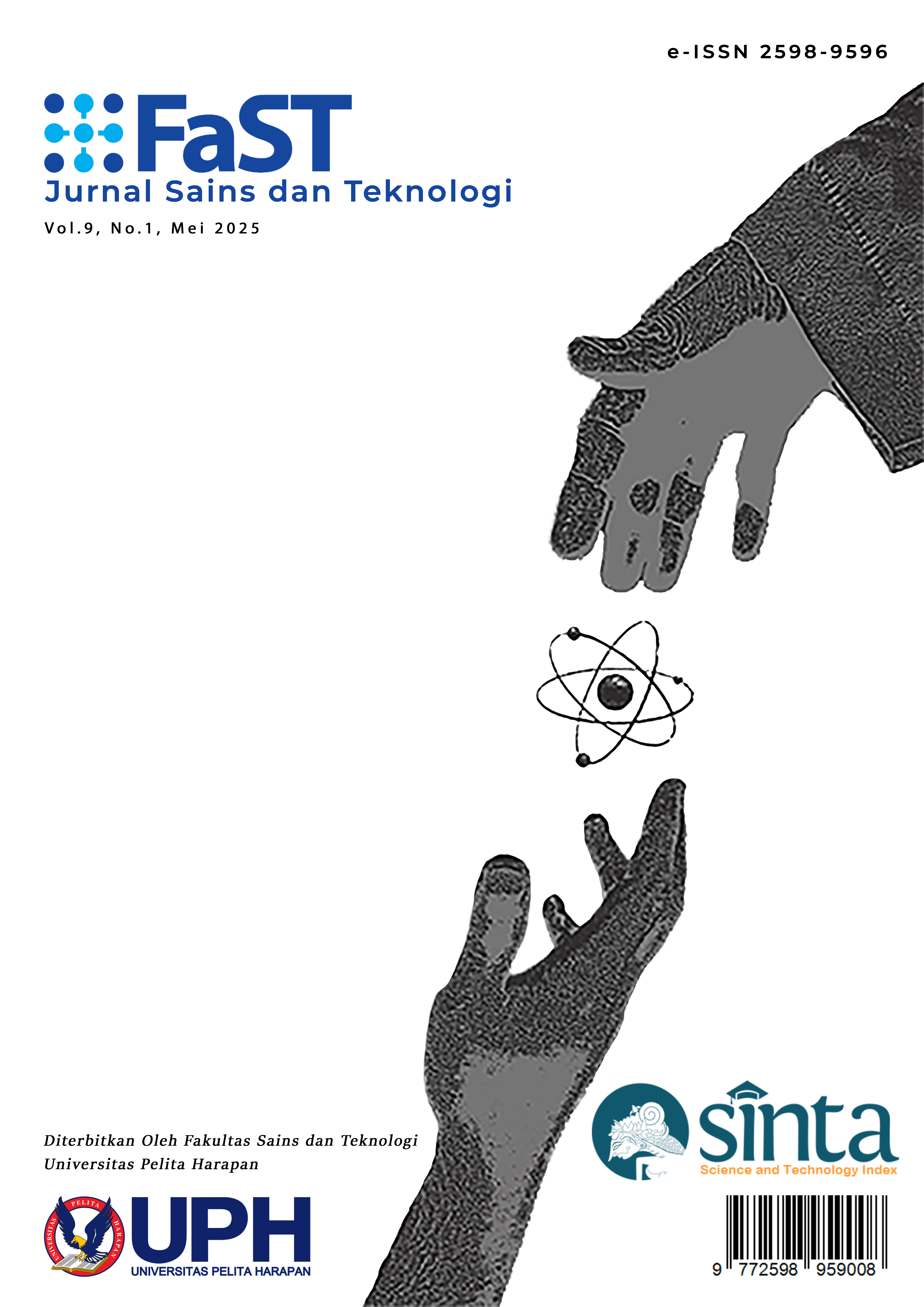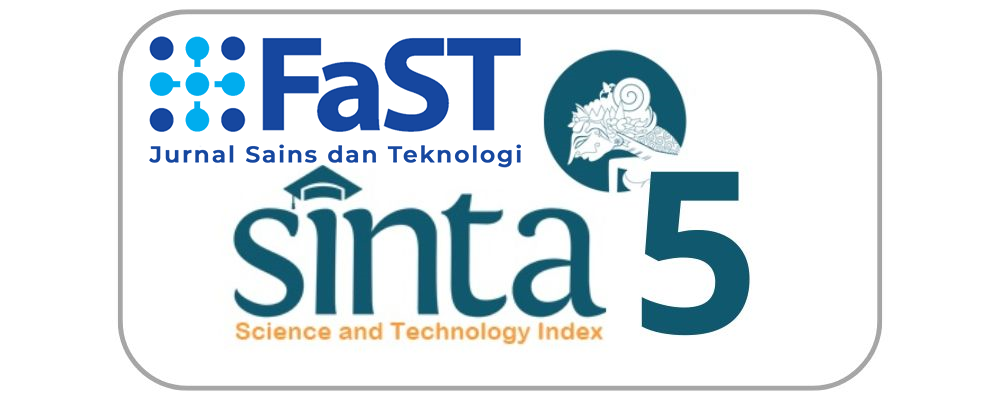Rancang Bangun Sistem Monitoring Kualitas Udara, Kecepatan Angin, dan Arah Angin Menggunakan Mikrokontroler ESP32 dan Visualisasi Data Menggunakan Blynk
[Design of Air Quality, Wind Speed, and Wind Direction Monitoring System Using ESP32 Microcontroller and Data Visualization Using Blynk]
DOI:
https://doi.org/10.19166/jstfast.v9i1.9159Keywords:
IoT, Blynk, ESP32 microcontroller, environmental monitoring systemAbstract
Air quality, wind speed, and wind direction monitoring system is a system that can measure environmental parameters that affect human health and comfort, as well as displaying real-time measurement data through an application. This system is designed and built using ESP32 microcontroller and data visualization using Blynk IoT platform. The system consists of three main components, namely sensors, microcontroller, and IoT platform. The sensors used are DHT22 sensor to read temperature and humidity, MQ135 sensor to read CO2 concentration, anemometer sensor to read wind speed, and wind direction sensor to read wind direction. These sensors send data to the ESP32 microcontroller, which then processes the data and sends it to the Blynk server via an internet connection. In addition, the measurement data is also automatically sent to a Google Spreadsheet using the Google Sheets API. This allows users to save data in a tabular format, perform further analysis, and store measurement history in the cloud. The Blynk app displays measurement data in the form of graphs, numbers, and color indicators. The test showed that the system can function well in measuring environmental parameters. Verification showed that the average relative errors in reading the parameters are as follows: temperature 1.7%, humidity 1.63%, CO2 concentration 1.99%, and wind speed 0.02%. These error values are within accepted tolerance level, hence the system is sufficiently accurate to measure environmental conditions.
Bahasa Indonesia Abstract: Sistem monitoring kualitas udara, kecepatan angin, dan arah angin adalah sistem yang dapat mengukur parameter-parameter lingkungan yang berpengaruh terhadap kesehatan dan kenyamanan manusia, serta menampilkan data hasil pengukuran secara real-time melalui aplikasi. Sistem ini dirancang dan dibangun dengan menggunakan Mikrokontroler ESP32 dan visualisasi data menggunakan Blynk. Mikrokontroler ESP32 adalah sistem berbiaya rendah dan berdaya rendah, terintegrasi pada chip mikrokontroler, dengan WiFi terintegrasi dan mode ganda Bluetooth. Blynk adalah platform perangkat lunak IoT berbiaya rendah dan berdaya rendah yang memungkinkan pengembang untuk membuat proyek terhubung dengan mudah. Sistem ini terdiri dari tiga komponen utama, yaitu sensor, mikrokontroler, dan aplikasi. Sensor yang digunakan adalah sensor DHT22 untuk membaca suhu dan kelembapan, sensor MQ135 untuk membaca CO2, sensor anemometer untuk membaca kecepatan angin, dan sensor arah angin untuk membaca arah angin. Sensor-sensor ini mengirim data ke mikrokontroler ESP32, yang kemudian mengolah data dan mengirimnya ke server Blynk melalui koneksi internet. Selain itu, data hasil pengukuran juga dikirimkan secara otomatis ke Google Spreadsheet menggunakan API Google Sheets. Hal ini memungkinkan pengguna untuk menyimpan data dalam format tabel, melakukan analisis lebih lanjut, dan menyimpan riwayat pengukuran secara terpusat. Aplikasi Blynk menampilkan data hasil pengukuran dalam bentuk grafik, angka, dan indikator warna. Hasil pengujian menunjukkan bahwa sistem dapat berfungsi dengan baik dalam mengukur parameter-parameter lingkungan. Rata-rata kadar CO2 adalah 310PPM. Rata-rata kecepatan angin adalah 1.2 m/s, dengan nilai minimum 0 m/s dan maksimum 3.1 m/s. Arah angin terbanyak adalah dari arah Tenggara (135°). Sistem ini dapat memberikan informasi yang bermanfaat bagi pengguna untuk mengetahui kondisi lingkungan di sekitarnya.
References
Dafa, Muh. D., Astutik, R. P., & Winarno, H. A. (2023). Smart io plc Berbasis IOT menggunakan ESP32. JOURNAL ZETROEM, 5(2), 165–168. https://doi.org/10.36526/ztr.v5i2.3120
Hercog, D., Lerher, T., Truntič, M., & Težak, O. (2023). Design and implementation of ESP32-based IOT devices. Sensors, 23(15), 6739. https://doi.org/10.3390/s23156739
Ismail, M. S., Mohammed, M. F., Sivaraman, K. N., Sivaraman, S. N., & Hussain, M. I. (2021). Smart IOT temperature and humidity alert system at aircraft composite storage area. AIP Conference Proceedings, 2339(1). https://doi.org/10.1063/5.0044198
Lynn, T., Endo, P. T., Ribeiro, A. M., Barbosa, G. B., & Rosati, P. (2020). The internet of things: Definitions, key concepts, and reference architectures. Palgrave Studies in Digital Business & Enabling Technologies, 1–22. https://doi.org/10.1007/978-3-030-41110-7_1
Pebralia, J., Akhsan, H., & Amri, I. (2024). Implementasi internet of things (IOT) dalam monitoring Kualitas Udara Pada ruang terbuka. Jurnal Kumparan Fisika, 7(1), 1–8. https://doi.org/10.33369/jkf.7.1.1-8
Project, I. (2025, April 23). Apa Itu Blynk? Platform IoT populer? https://indobotproject.com/
Satish, U., Mendell, M. J., Shekhar, K., Hotchi, T., Sullivan, D., Streufert, S., & Fisk, W. J. (2012). Is CO2 an Indoor Pollutant? Direct Effects of Low-to-Moderate CO2 Concentrations on Human Decision-Making Performance. Environmental Health Perspectives, 120(12), 1671–1677. https://doi.org/10.1289/ehp.1104789
Umah, R., & Gusmira, E. (2024). Dampak Pencemaran Udara Terhadap Kesehatan Masyarakat di Perkotaan. Profit: Jurnal Manajemen, Bisnis Dan Akuntansi, 3(3), 103–112. https://doi.org/10.58192/profit.v3i3.2246
Yanti, Y. (2024). Sistem Monitoring Keamanan Kantor Berbasis Android menggunakan modul wireless ESP-01. Jurnal Informatika Dan Teknik Elektro Terapan, 12(1), 312–321. https://doi.org/10.23960/jitet.v12i1.3734
Downloads
Published
Issue
Section
License
Copyright (c) 2025 Abdur Rahman Haritsah, Henri P. Uranus

This work is licensed under a Creative Commons Attribution-ShareAlike 4.0 International License.
“Authors who publish with this journal agree to the following terms:
1) Authors retain copyright and grant the journal right of first publication with the work simultaneously licensed under a Creative Commons Attribution License (CC-BY-SA 4.0) that allows others to share the work with an acknowledgement of the work's authorship and initial publication in this journal.
2) Authors are able to enter into separate, additional contractual arrangements for the non-exclusive distribution of the journal's published version of the work (e.g., post it to an institutional repository or publish it in a book), with an acknowledgement of its initial publication in this journal.
3) Authors are permitted and encouraged to post their work online (e.g., in institutional repositories or on their website). The final published PDF should be used and bibliographic details that credit the publication in this journal should be included.”



